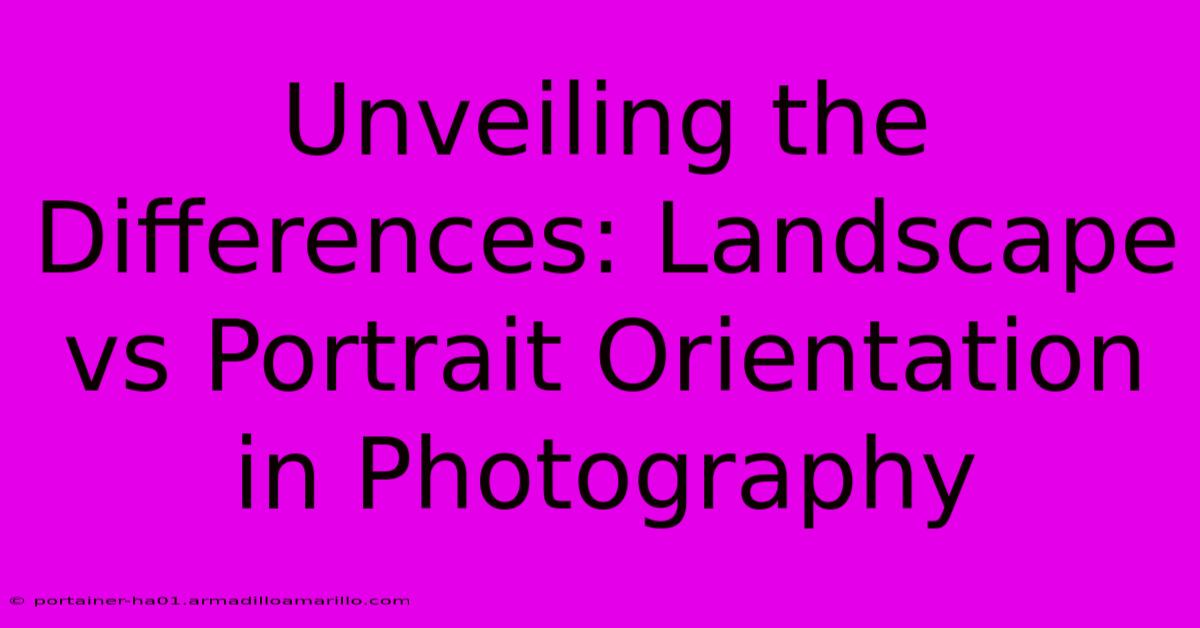Unveiling The Differences: Landscape Vs Portrait Orientation In Photography

Table of Contents
Unveiling the Differences: Landscape vs Portrait Orientation in Photography
Choosing between landscape and portrait orientation in photography is a fundamental decision that significantly impacts the mood, message, and overall impact of your image. While both orientations have their strengths and weaknesses, understanding their distinct characteristics allows you to make informed choices that elevate your photographic storytelling. This article delves into the nuances of landscape versus portrait orientation, helping you master this crucial aspect of composition.
Landscape Orientation: The Wide-Open Perspective
Landscape orientation, also known as horizontal orientation, is characterized by its wider horizontal expanse. This creates a sense of breadth and openness, making it ideal for capturing sweeping vistas, expansive landscapes, and scenes emphasizing width and scale.
When to Use Landscape Orientation:
- Landscapes (obviously!): Mountains, oceans, forests, and sprawling fields are naturally suited to landscape orientation, showcasing their grandeur and vastness.
- Architectural Photography: Capturing the full expanse of buildings, especially those with horizontal lines, benefits significantly from this orientation. Think wide shots of city skylines or the impressive facade of a large building.
- Group Photos: Landscape orientation is often preferred for large group photos, ensuring everyone fits comfortably within the frame.
- Action Shots: Certain action shots, particularly those emphasizing movement across a wide area (e.g., a race car speeding across a track), are enhanced by the horizontal format.
The Impact of Landscape Orientation:
The horizontal format often creates a feeling of calmness, stability, and tranquility. The wide view invites the viewer's eye to wander, exploring the details within the scene. It fosters a sense of scope and grandeur, ideal for conveying vastness and majesty.
Portrait Orientation: Focus and Intimacy
Portrait orientation, or vertical orientation, is characterized by its height, emphasizing vertical lines and creating a sense of depth and intimacy. This orientation naturally draws the viewer's eye towards the subject, making it perfect for emphasizing height, detail, and individual elements.
When to Use Portrait Orientation:
- Portraits (naturally!): This is the classic use case, ideal for capturing individual subjects and showcasing their features and expressions. The taller frame emphasizes the subject's height and creates a more intimate connection with the viewer.
- Tall Structures: Buildings like skyscrapers, tall trees, or waterfalls benefit from the vertical perspective, highlighting their height and imposing presence.
- Detailed Close-ups: When focusing on a specific detail or object, portrait orientation allows you to isolate it, emphasizing its texture, color, and form.
- Emphasis on Vertical Lines: Scenes with prominent vertical lines, such as rows of trees or urban streets, look stunning in portrait orientation.
The Impact of Portrait Orientation:
Portrait orientation often conveys a feeling of height, power, or intimacy. The vertical alignment directs the viewer's attention towards a specific point, emphasizing the subject and drawing the viewer into the scene. It can also create a sense of drama and intensity, especially when used to capture a single striking element.
Breaking the Rules: Creative Composition
While the above guidelines are helpful, photography is an art form where experimentation is key. Don't be afraid to break the rules and use landscape or portrait orientation in unconventional ways. Sometimes, an unexpected orientation can create a surprisingly powerful and memorable image. Consider:
- Unusual perspectives: Experiment with angles and viewpoints to challenge conventional expectations.
- Rule of thirds: This composition guideline applies regardless of orientation. Place key elements along the intersecting lines of your imaginary grid.
- Leading lines: Use natural lines (roads, rivers, fences) to guide the viewer's eye through the image, regardless of orientation.
Conclusion: The Right Choice for Your Vision
Ultimately, the choice between landscape and portrait orientation depends entirely on your artistic vision and the message you want to convey. By understanding the strengths and nuances of each orientation, you can make conscious choices that enhance your photographic storytelling, ensuring your images resonate with power and impact. Experiment, explore, and find what works best for you – your creativity is the ultimate guide!

Thank you for visiting our website wich cover about Unveiling The Differences: Landscape Vs Portrait Orientation In Photography. We hope the information provided has been useful to you. Feel free to contact us if you have any questions or need further assistance. See you next time and dont miss to bookmark.
Featured Posts
-
Email With A Twist 9 Sign Offs That Will Make Them Smile
Feb 07, 2025
-
Nail Envy Exposed Secrets To Achieving Salon Quality Manicures With A Dnd Nail Lamp
Feb 07, 2025
-
Eggplants Enigma Reveal The Surprising Purples Hidden In A Veggie
Feb 07, 2025
-
Lavenders Lullaby Drift Into Serene Slumber With The Sweetest Purple
Feb 07, 2025
-
From The Silver Screen To Your Kitchen Discover The Enchanting Appeal Of Big Chill Appliances
Feb 07, 2025
